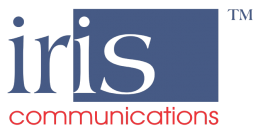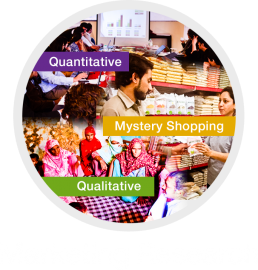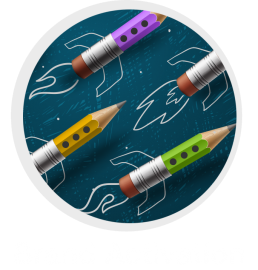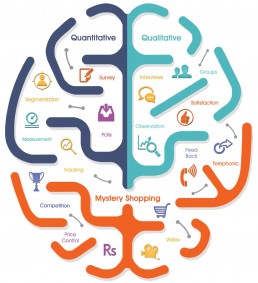iris does two big things: we help client organizations understand their customers. And we help customers understand—and love—our clients’ brands. Marketing research is how we help our clients get to know their customers deeply—their needs, preferences, behaviors, what motivates them, and why. Brand activation is how we get customers to know and love our clients and their brands.
Marketing Research
Every business decision is made on the basis of something. In the absence of hard data, that something might be guesswork. Or fear. Or force of habit. At iris, we understand that reliable data is the starting point for any meaningful decision-making.
We use mixed methods:
QUALITATIVE
QUANTITATIVE
MYSTERY SHOPPING
to deliver our clients data they can trust. Then we present it to them in clear, jargon-free reports and presentations so they understand how to translate research findings into concrete next steps.
QUALITATIVE RESEARCH
Quantitative and qualitative research are like two wings of a hawk: when working together, they raise us to an elevated understanding and provide a panoramic view of the situation on the ground. Quantitative data gives a factual basis for planning—a snapshot of a situation. Qualitative information can go deeper, to find out the things that really matter to consumers. For example, in a quantitative survey, 80 out of 100 consumers might confirm that they prefer one brand of tea over another. But valuable information comes from understanding what drives that preference. Is it the smell? The taste? The packaging? The name? The price? A combination?
iris takes pride in providing our clients with a rich understanding of their target audience, producing methodologically rigorous but reader-friendly research. We analyze information conveyed through language and behavior about beliefs, values, feelings, and motivations that underlie behaviors. Our approach identifies what consumers say they want—as well as the needs they haven’t articulated yet.
Our research expertise includes study design, technical advice and support, reference materials, qualitative software, audio and video taping, interviewing and transcription services, and observation facilities. We employ a team of experienced in house researchers and moderators for in-depth exploration of perceptions and development of insights. We use experienced field staff to recruit across all socioeconomic classes, and highly trained supervisors to keep a check on project quality. In addition to our on-site facilities, we also conduct groups throughout Pakistan, so whether it be Islamabad or Quetta, iris provides the same high level of recruitment and client support services.
Qualitative research methods
iris offices are equipped with focus-group studios, complete with two-way mirrors and audio recording technology. In-studio focus group discussions are sometimes logistically desirable (if, for example, there is a critical mass of discussants to be found in reasonable proximity to our office locations). Often, however, iris prefers to run in-home focus group discussions, equipping one room in a focus-group discussant home with the necessary equipment. It is a good way to gather people from similar backgrounds to discuss a specific topic of interest. The group of participants is guided by our in-home moderators (or group facilitators) who introduce topics for discussion and help the group to participate in a lively and natural discussion amongst themselves. The moderators’ skill at facilitating the discussion is important because the strength of the focus group method ultimately depends on the freedom participants feel to agree or disagree with each other. The most useful discussions deliver insight into how a group thinks about an issue, about the range of opinion and ideas, and about the inconsistencies and variations among a particular community in terms of their beliefs, experiences, and practices. iris uses FGDs to understand the meanings of survey findings that cannot be explained statistically, to explore the range of views on a topic of interest, and to collect a wide variety of local terms.
In-depth interviews offer the opportunity to capture rich insights into people’s behaviors, attitudes and perceptions. iris prefers in-depth interviews to be carried out face-to-face so that a rapport can be created with respondents—body language contributes greatly to power of the in-depth interview.
Ethnographic studies involve observing respondents in their own real-world setting, rather than in the artificial environment of a lab or focus group. Ethnographic research helps us to understand behavior and gather insight into how people live—what they do, how they use things, what they need in their everyday or professional lives. iris finds this approach is most valuable at the beginning of a project when there is a need to understand real end-user needs or to understand the environmental conditions in which a new product or service might be used by a particular audience.
Our qualitative researchers visit consumers in their homes, observe and note tangible and intangible cues that tell a consumer story; noting their consumption patterns of products, and engage them in deep conversations pertaining to the subject matter. Our experienced and qualified researchers are keen observers and are able to capture subtle details that would not be present in a controlled focus group setting.
This method provides an overall view of a given brand’s performance across all touchpoints and marketing efforts. iris can measure and diagnose the impact each touchpoint has the brand’s equity. We identify the most effective touchpoints so that our clients can extend their brand’s message more impactfully and adjust media spend as necessary
QUANTITATIVE RESEARCH
Quantitative Research seeks to determine the size or scope of a problem or an issue by generating numerical data that can be analyzed statistically. For iris clients, quantitative data provides market sizing, forecasting, trend analysis, and other information vital to sound business decision-making. iris uses the most advanced quantitative data collection techniques to yield the most precise and reliable information. The data is backed by statistical analysis and testing to uncover patterns and formulate reliable hypotheses.
The quantitative methodology typically involves designing questionnaires and scales. People who respond (respondents) are asked to complete the survey. Then marketers use the information obtained to understand consumer needs and preferences, and to create marketing strategies.
Tools of Quantitative Research
PAPI: Pen and Paper Interviewing is a traditional, old-school way of gathering information from the target audience. It has been widely used but is time- and labor-intensive—as competition increases, companies tend to prefer more advanced tools.
CAPI: Computer Aided Personal Interviewing tool has emerged as one of the key tool to save time as well as the cost of paper. Information is collected on computer-based interface on either tablets or laptops, which reduces the time for data entry.
Methodologies
- DDS: Door-to-Door studies are conducted with target audience in their homes to gather information related to different aspects of daily life through structured questionnaire. Information gathered is usually generic and focused on a particular sector i.e., personal care, apparel, political polls etc.
- CLTs: Central Location Tests are also conducted through structured questionnaire but in a controlled environment so that the real-life elements don’t distract or affect the opinion of the respondents. CLTs are usually used when sensitive information like a touch-, smell,- or taste-test of products is needed – in either blind or branded form. CLTs may cover (but are not limited to) product tests, packaging tests, or concept tests.
- HUT: Home Usage tests are conducted where the real-life elements are a factor to consider while getting the opinion of the target audience. HUTs usually involve giving the respondents samples of products to use at their homes, and then collecting their feedback after a short period of time (e.g., 2-3 days – depending on the product.)
- Tele surveys: Tele surveys involve a structured questionnaire administered via calls to landline or mobile phones. These are specifically conducted where customer information such as name and contact detail are available – usually in banking and apparel sectors.
- Mall intercepts: Mall intercepts are conducted with walk-in customers during their visit to malls to gauge their shopping experience. These help in identifying customer preferences as well as the key areas of improvements.
- Exit interviews: Exit interviews also use a structured questionnaire and are conducted with the target audience at the exit point of outlet/branch they were visiting for either shopping Or other business. These are also usually conducted to ascertain customer satisfaction in banks and apparel sector.
- Appointment-based Interviews: These are specialized interviews similar to Qualitative In-Depth-Interviews in that detailed information is collected from a selected profile of respondents. Based on customer database, target audience are contacted for appointments and are then visited at either their homes or workplaces for face-to-face interviews. Appointment-based interviews are used in a variety of sectors when critical information is required from a specific target audience profile.
Services
U & A studies: Usage & Attitude studies capture a range of information related to products or services being used by target audiences. Awareness and consumption/purchase behavior are assessed through such studies; they are used widely in variety of sectors.
Product tests: Sample products are tested with the target audience to gauge their feedback. These are usually conducted in controlled environments to eliminate any chances of external biases. These are usually conducted in blind form so that the brand name doesn’t condition the response.
Packaging tests: Sample packaging is tested with the target audience to gauge their feedback on different aspects of the packaging. Detailed insights lead to improving shape, color combinations, logos, and other elements. These are also preferably conducted in controlled environments.
Ads/Television commercial tests: Print Ads and TVCs are tested with target audience by showing them the advertisements and then gauging their feedback on the acceptability, uniqueness, and other aspects of the advertisement. These also include evaluation of models, jingle, and general look-and-feel of the advertisement. These tests are conducted in purely controlled environment.
Concept tests: New product/service concepts are tested with target audience to gauge their feedback on the comprehension, benefits, acceptability and uniqueness of the concept. Concept tests cover a wide range of products and services in a variety of sectors (e.g., fast-moving consumer goods, banks, apparel, etc.).
Brand tracking: Brand tracking studies help companies keep track of the performance of their products/service over a period of time. These are very useful in identifying which specific elements of the products or services need to be improved.
Political polls: Political polls are conducted to ascertain general audiences’ preferences towards different political parties. Political polls are usually conducted nationwide to help identify the performance of political parties in different geographical segments of the country.
CSS: Customer Satisfaction Surveys are conducted primarily with existing customers. They help identify the key elements on which the customers are satisfied or dissatisfied with the performance of a product or service.
Customized research studies: The general trend in research is towards ever-greater customization. CRS projects usually involve a combination of qualitative and quantitative methods based on sharply defined and highly specific research objectives.
MYSTERY SHOPPING
Mystery Shopping is a must-use tool for any consumer business that is serious about its bottom line. Most companies spend considerable time, effort, and money on new-customer acquisition. All of it is wasted unless that customer is retained—and last year 86 percent of consumers quit doing business with a company because of a bad customer experience, up from 59 percent four years ago. (Harris Interactive, Customer Experience Impact Report). Mystery shopping—sending trained evaluators, posing as customers, to interact with a company’s customer-facing staff—can be a humbling reality check for many companies. But no company can afford not to get an objective view of its business through the eyes of the customer. Not when inadequate customer service can erode a customer base by as much as 40 percent. And not when a report by McKinsey (2014) found that companies focused on maximizing satisfaction have the potential to increase customer satisfaction by 20 percent.
iris communications has been conducting mystery shopping since 2006 for clients in a wide range of industries. We have a large pool of experienced mystery shoppers and we specialize in tailored solutions that deliver much more than just a set of data to our clients. iris uses mystery shopping instead to provide h a complete customer service management solution.
Features of Mystery Shopping Program
at iris communications
- Feedback – Specifically designed for improved performance to meet standards
- Timeliness – Prompt feedback guaranteed
- Reliability – Guaranteed accuracy in evaluations. Every evaluation is checked for quality control
- Company consistency – Every location (branch/outlet) is evaluated using the same standards
- Competition – Consistent analysis provides a basis to attain competitive advantage
- Identification – Provides information to reward areas that exceed quality standards and identify where improvement may be needed
- Access results in real time– we provided tailored user access to our web-based portal to see results in real time, saving time and empowering a client to act faster
Types of Mystery Shopping Offered
by iris communications
- Standard (in-store)
- Video Mystery Shopping (VMS)
- Telephonic Mystery Shopping
- Competition Mystery Shopping
- Competitive Watch
- Branch Assessment
- Health Check
- Application Seeding
- Price Survey
- Price Control
Experience
iris has the expertise of conducting mystery shopping programs for clients pertaining to the following sectors:
- Financial services/banking
- FMCG (fast-moving consumer goods)
- Telecommunications
- Apparel
- Footwear
- Retail
- Home furnishings
- Education
Brand activation
The process of making a brand well known and loved by consumers is called brand activation. At iris, we focus on three core brand-activation disciplines:
Consumer engagement
When consumers make purchases, they are not just buying products. They are also making statements that the brands resonate with their identities and lifestyles. Traditional advertising aims to link a brand with certain images or themes. But consumer engagement—defined simply as the interactions between a brand and its customer—can shape those brand associations in much more organic and natural ways. Consumer engagement provides real business value in many ways, from increasing conversions and sales to improving average order value and customer lifetime value.
Consumer engagement can – and should – happen simultaneously across multiple online and offline marketing channels. It is the lifeblood of any sophisticated marketing organization’s strategy. Skilled marketers can guide this engagement to serve their business needs, while also providing consumers with an authentically enjoyable experience.
Examples of consumer engagement:
- In-store activation. A brand can be activated using point-of-purchase displays with attractive design, or hosting retail product launch experiences that allow consumers to experience and try a particular product. iris is typically responsible for providing on-demand staffing or for training the client’s own in-store team to deliver the brand message to customers. iris also manages free samples or any other promotional item.
- Trade/merchandising drives. Promotions aimed at retailers or distributors by the companies to promote their brands. EXAMPLE
- School/college edutainment. iris recommends school and college activations for brands whose customer base includes younger people. For example, Clean and Clear is an anti-acne product aimed at adolescent girls. iris developed a school-based activation that included general grooming advice as well as information specifically about age-appropriate skin care. Engagements like this help build brand loyalty.
- Rural activation. Rural areas are a huge market for brands, and live events that bring together communities that are often small or isolated are a popular strategy. Rural activations tend to be loud to gain attention and dramatized to get the message across. For example, an activation produced for FMC, a company serving farmers, involved a theater plan where the product message was delivered via mascots. The theatrical production was an entertaining novelty for the target audience of farmers, and the message was well received.
Event Management
iris has proven expertise in every aspect of event management: creative conception, planning, staffing, on-site management, and even the one that’s most often overlooked: a systematic debrief that evaluates whether the event achieved specific, measurable objectives. iris knows the local market. We have excellent relations and negotiating power with vendors. We maintain strict respect for budget and schedule. All this means that special events for iris clients are creative, impactful, and long remembered after the fact.
Types of events
- Concerts
- Commercial event
- Product launches
- Trade shows
- Conferences
Fabrication
iris has in-house capacity not only to design but also to fabricate a complete inventory of marketing materials, whether intended for interior or outside spaces.
Types of Fabrication:
- Corporate stalls
- Innovative merchandising tools
- Display racks/gondolas, shop sign
- Gift items
- Digital and offset printing



